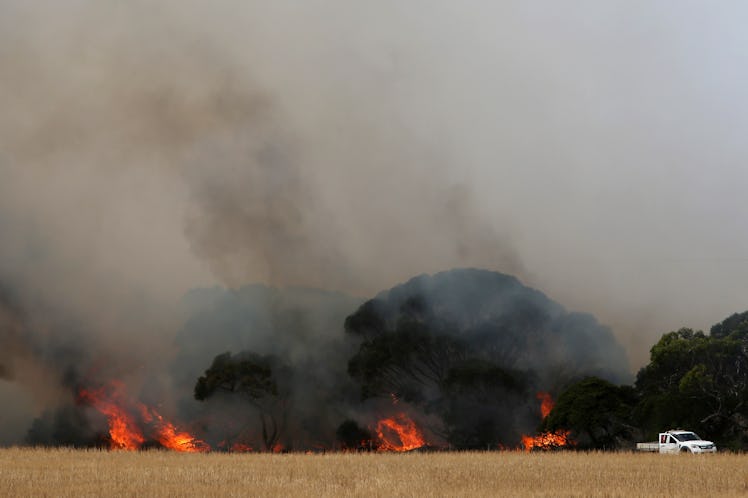
Here's What An Expert Says About Australia Recovering From Bushfires
The fires that have burned across Australia since September continue to threaten much of the country as heatwaves and other severe weather conditions develop. Thus far, the ongoing bushfire crisis has destroyed thousands of homes and killing approximately 30 people, per the BBC. According to CNN, these are some of the worst fires Australia has experienced in decades, and firefighters are still struggling to contain them. Given how much damage they have caused, can Australia recover after the bushfires? These blazes are expected to significantly alter the country's delicate ecosystems.
Australia's fires have been so severe that they've been generating their own weather patterns. According to NASA scientists, the heat from the fire has contributed to the development of large clouds called pyrocumulonimbus, or pyroCbs. Because of these clouds, there have been fire-induced thunderstorms and fire tornadoes, and smoke from the fires has spread to countries "halfway around earth," per NASA.
Officials estimate that some one billion reptiles, birds, and mammals have been killed by Australia's fires, and even rainforests can't withstand the blazes. So how can Australia recover from these fires? In the short term, the country will need to handle fire victim relief, property repairs, and habitat restorations. But in the long term, Australia and other countries will need to prioritize the fight against climate change, which has likely made the fires worse.
Rodney Keenan, a professor of forest and ecosystem science at the University of Melbourne, tells Elite Daily that fires don't always destroy entire ecosystems. Many forests and wildlife are adapted to fires, Keenan says, noting that many trees — such as eucalyptus — can regenerate and recover following a fire. But not all Australian regions are equally resistant to high-temperature fires like the ones the country has recently experienced.
"Some sub-tropical and temperate rainforests have been burnt that are not tolerant of fire," Keenan explains. "Their recovery capacity will need to be monitored. The capacity of forests to recover will also depend on available seeds sources."
Some tree and plant species produce seeds with a tough coating that may remain dormant until a fire, after which they are released. But if a specific forest experiences multiple fires in rapid succession, then the trees that grew out of the seeds from the first fire might not be able to produce new seeds. In light of this, Keenan recommends that humans monitor affected ecosystems and intervene to preserve them, or the longterm consequences could be drastic.
"These eucalyptus species that depend on seed regeneration may disappear from these areas without human intervention," Keenan adds. "Humans can undertake works to prevent soil erosion, reseed or replant areas that have burnt intensely and undertake activities to reduce the risk of future fires. This might include more regular prescribed burning."
Keenan points to traditional indigenous land management techniques as a way to lessen the severity of such fires. Indigenous fire management involves setting small-scale fires in controlled environments in order to prevent future devastating fires, like the ones that Australia is currently experiencing. If Australian officials collaborate with indigenous communities to implement such practices — which the New South Wales Rural Fire Service currently does, per TIME — they could help prevent fire-based disasters and protect Australia's diverse landscape. According to Keenan, factors like weather conditions and forest structure contribute to a fire's intensity, so applying Aboriginal fire management techniques could help suppress fires by reducing flammable material in the area around a fire.
But Australia's ecosystems aren't the only things that will require intensive recovery after this record-breaking fire season. Australia will also need to invest in property repairs and victim relief funds to support people and communities that have been impacted by the fires. Nonprofits and charities like the World Wide Fund for Nature (WWF) Australia have already launched initiatives to restore forests and other natural habitats. WWF Australia also wants to prevent future deforestation.
Given how long these fires have been burning, Australia's economy could use a boost, too. In article published on Jan. 13, Simon Baptist, chief economist at The Economist Intelligence Unit, told Wired UK that boosting Australia's GDP will take approximately six to 12 months, and will be spurred by the onset of reconstruction and recovery projects. Ultimately, however, boosting the country's economy and investing in short-term repairs won't be enough. Australia, which is a top exporter of coal, must also contend with the fact that coal is an enormous source of greenhouse gases, and a significant contributor to climate change. Climate change has exacerbated natural disasters across the world — including Australia's bushfires, Keenan says — and a long-term plan to fight climate change must be part of any recovery effort.
"Reduce CO2 emissions so that we are lowering the possibility of even more extreme fire risks in future," Keenan advises. "Manage our forests better." He suggests strategies like more prescribed burning, thinning of dense forest areas, and maintaining fire breaks.
For now, Keenan says, it's too soon to tell exactly how quickly Australia's forest and wildlife will recover from the bushfires. But what's sure is the country needs to carefully monitor the country's diverse ecosystems in order to preserve endangered species and prevent future fires of this scale.